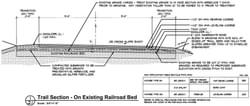




From Michigan State Parks and Recreation Division
A new asphalt mix was developed and tested to better withstand snowmobile traffic during the winter months, and to provide a more durable surface for summer trail use.

In 2007, the Michigan Department of Natural Resources, after years of asphalt mix testing, contracted for the installation of 8.05 miles of trail surfacing on the 92-mile Fred Meijer/White Pine Trail in Kent County, Michigan at a cost of $1,033,000. This trail surfacing project used an asphalt mix that was developed and tested to better withstand snowmobile traffic during the winter months, and to provide a more durable surface for summer trail use.
The Michigan Snowmobile Association (MSA) spent over 6 years working with the Michigan Department of Natural Resources in the testing and funding of suitable asphalt mixes. This new trail surfacing mix on the Fred Meijer/White Pine Trail will significantly improve the durability and maintenance of trails where winter snowmobile traffic takes place.
The Michigan Snowmobile Association and the Michigan State Parks and Recreation Division deserve the 2008 National Trails Nomination Award in the category of State-of-the-Art-Technology. This project is an example of an organization addressing a trail issue, and spending the time and resources to find a long term solution.
In early 2002, the MSA approached Rieth-Riley with a unique problem. Most of the paved snowmobile trails in the State are multi-use trails (snowmobiles in the winter – bikers and rollerbladers in the summer). The metal studs that are commonly used in the treads of the snowmobiles, as safety enhancing devices, along with their carbide runners had been damaging the paved trails. This damage was creating a rough and undesirable surface for the summer time users as well as shortening the useful life of the pavement. The MSA asked Rieth-Riley to investigate the possibility of creating a bituminous mixture that would be more resistant to the steel studs and carbide runners than the conventional mixtures that the State was currently using.
Over the course of the next year, Rieth-Riley created and implemented a “Snowmobile HMA Mix Design Research Plan.” The initial phase of the research plan involved creating and testing 10 experimental mixes. Each mix was performance tested utilizing test equipment supplied by two snowmobile stud and wear bar manufacturers. Each mix was cooled to the anticipated in situ temperature and then subjected to repetitive loading from both studs and carbide runners via the air actuated test apparatus. The top performing mixes were then selected for field testing. Gyratory samples of each mix (prepared at the specified Air Voids & VMA) were placed in the Musketawa Trail where snowmobile damage had become a much debated topic.
Partnering efforts between the Michigan Department of Natural Resources (MDNR), key legislators (Michigan Speaker of the House, Wexford County Commissioner), local officials (Cadillac Visitors Bureau), the MSA and Rieth-Riley soon led to a pilot project involving 4 miles of paved trail.
In the summer of 2003, Rieth-Riley constructed 4 miles of snowmobile trail on the Pere Marquette Trail. The project included four 1 mile test sections. Three of the sections were constructed with the top performing “test” mixes while the remaining one mile section was constructed with a conventional Marshall mix.
A requirement of the pilot project includes quarterly monitoring to evaluate the performance of each test section. To date, the performance of the test mixes has far exceeded that of the conventional Marshall mixes (see attached photos). While each of the test sections does show some stud and runner wear, at acceleration an deceleration points, the degree of wear is significantly less than that of the conventional Marshall mix and, therefore, has improved the functionality and useful life of a multi-use paved trail system.
With every passing year, popularity of each recreational use of the trail system will continue to increase. This pilot project has laid the ground work for future miles of trail to be constructed of bituminous pavement that will exceed conventional performance, reduce lifecycle costs and improve recreational use while portraying the asphalt industry in a very positive light.
The MSA received a national award on this trail mix from the National Asphalt Paving Association, the award category was “non-typical pavement quality in construction.”
Superpave Mix Design Criteria
% Gmm@Ndes................................... 97.5%
% Gmm@Nini.................................... N/A
% Gmm@Nmax................................. N/A
VMA min % at N des (based on Gsb)... 16.0%
Fine Aggregate Angularity Minimum.... 46
Crush Minimum Criteria...................... 100%
LA Abrasion Maximum Criteria............. Combined Blend - 30 -- Air Cooled Blast Furnace Slag - 35
Fines to effective binder ratio (P No 200 1Pbe).. 0.8 - 1.4
Soft Particle Maximum Criteria.......................... 5.0%
N ini gyrations.................................................. 7
N des gyrations................................................ 86
N max gyrations.............................................. 134
Gradation
Standard Sieve - % Passing Criteria
3/8" Sieve............ 100
#4 Sieve............... 90 - 100
#8 Sieve _____
#16 Sieve............. 30 - 60
#30 Sieve _____
#50 Sieve _____
#100 Sieve _____
#200 Sieve........... 6 - 12
* THE DESIGN OF THE HOT MIX ASPHALT (MIX TYPE SM) FOR THE SNOWMOBILE TRAIL MIX PAVING WAS DESIGNED BY REITH RILEY CONSTRUCTION CO., INC., 867 EGYPT VALLEY ROAD, P.O. BOX 278, ADA, MI 49301, (616) 676-0446.
Mixture Composition
Asphalt Type - PG 70-28 (P) (a.)
Binder Content (minimum) - 7.5%
Slag Sand - % of Aggregate Blend (b.) - Min. 35%
Trap Rock - % of Aggregate Blend - Min. 25%
a. In accordance with MDOT Special Provision for Polymer Modified Performance Grade Binders
b. Slag sand must be 30-A Air Cooled Blast Furnace Slag: LA Abrasion of 35 and AWl of 333.
c. The HMA SM Mix design is the Reith Riley Test Mix #3 used on the Pere Marquette Trail Evart to
Hersey Pavement Evaluation Project.
Superpave Mix Design, Superpave Series No.2 (SP-2). Asphalt Institute, Research Park Drive, PO Box
14052, Lexington, KY 40512 - 4052
Mix Designs must be prepared in accordance with the Superpave Mix Design Manual